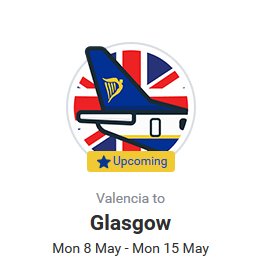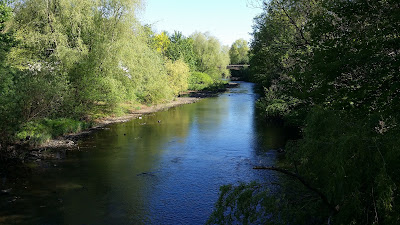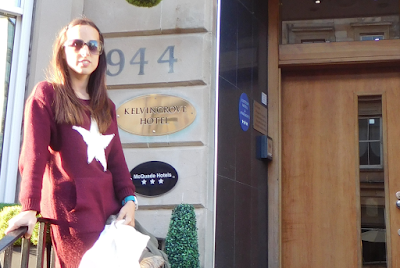MY TRIP TO scotland
Scotland is one of the countries that I've always dreamt of visiting... So, finally that dream has been fulfilled! This is my third trip I make to see my fav music band: TAKE THAT (after Munich 2011 and London 2015). When I was trying to buy a ticket several months ago, I considered going to Swansea or Manchester... but I coudln't! I The demand for Manchester and London is always high and I bought a ticket to Glasgow, at last. And I'm very happy with this decision... Scotland is a wonderful country!
This was the Tweet from @WhatsOnGlasgow announcing this event...
Initially I would travel alone but I spoke with a comrade and she had holidays during these days... and she decided to come with me. I chose the accommodation well in advance through Booking.com: a Twin Room at The Kelvingrove Hotel.
This family-run hotel is in the West End of Glasgow, 700 m from the Exhibition Centre (Glasgow) Rail Station, 600 m from the Kelvingrove Art Gallery and Museum and 900 m from the SECC (Scottish Exhibition and Conference Centre). Moreover it's close to the shops, restaurants and bars of Glasgow city centre. Sauchiehall St. is one of the main shopping and business streets in the city!
8th May (Monday)
Our flight was leaving so early: 7.10 am. My travel companion, Roser, and another comrade, Roberto, came to pick me up around 6 in the morning. We arrived at the airport of Manises when it was still night... Fortunately we didn't have to check the baggage. I carried a suitcase, a portfolio and a toiletry bag special for trips, all well-organised. The plane was then 15 minutes late in leaving. The flight from Valencia to Glasgow takes three hours. The flight went perfectly! We arrived early morning at Glasgow Airport, located 13km (8 miles) west of Glasgow. There we took a taxi to the hotel (around £22-23).
PHOTOS 1st day
Still at the Airport of Manises. Departures
Still at the Airport of Manises. Departures
Waiting for our Ryanair flight to Glasgow
Before boarding our flight
Inside the plane. Bye bye Valencia!
Taking photos during the flight
Flying above the clouds
#SelfieTime
Green areas, attractive views
The plane is descending...
Scoooooootland
Landing in Glasgow
Glasgow Airport (15.9 km west of Glasgow city centre), is the second-busiest in Scotland, after Edinburgh Airport. Some pics at the airport's entrance before taking a taxi
In the taxi on the way to the hotel
The taxi driver was a man in middle age that turned out to be very friendly and talkative!
Here we were going through the Clyde Tunnel, a crossing beneath the River Clyde
Here we were going through the Clyde Tunnel, a crossing beneath the River Clyde
Kelvin Way Bridge
Kelvingrove Park, one of my very favourite places in Glasgow
Direction signs
The River Kelvin
Views of Glasgow University tower from Kelvingrove Park
Silent and peaceful landscape, the ideal place to relax and unwind
In Scotland there're many beautiful parks which are ideal for a stroll
during the warm summer-days or even the romantic spring nights
River Kelvin
Crossing a bridge over the river
#SelfieTime
Artist George Wyllie's Sculpture of the fictional steamboat Vital Spark in Kelvingrove Park
Edinburgh and Glasgow have more green space than any other of the UK's 10 most populated cities. Glasgow has been named one of the top three eco-friendly cities in the UK because of its large amount of green space and low energy
Kelvingrove Art Gallery and Museum
Statue representing " Commerce & Industry" on bridge on Kelvin Way Bridge
"Philosophy and Inspiration" statue on Kelvin Way Bridge (north-west abutment). The figure of a mature man dressed as a scholar contemplates the meaning of existence. On the other side of the central street light pillar section, a young woman musician gazes out in a trance, in a moment of inspiration
Kelvingrove Art Gallery and Museum. Statue of St Mungo as the patron of Art and Music at the rear of the building. The sculptor was George Frampton, and the statue was unveiled in 1900. Kentigern known as Saint Mungo was born around 518 at Culross in Fife and brought up by St Serf at the monastery there. By 543 he had began missionary work at Cathures on the Clyde, the site of modern Glasgow. The Christian King of Strathclyde, Roderick Hael, welcomed Mungo and procured his consecration as bishop, which took place about 540. For thirteen years he preached in the area, living an austere life. A large community grew up around him and ultimately it became known as Glasgow. About 553 Mungo travelled to Wales, where he visited St David and founded St Asaph's Monastery before returning to Glasgow about 581. He died c 603 and is reputedly buried on the spot where Glasgow Cathedral now stands
Kelvingrove Art Gallery and Museum is one of Scotland's most popular free attractions. It has been a favourite with Glasgow residents and visitors since it opened in 1901. The museum has 22 themed galleries displaying an astonishing 8000 objects, brought together from across Glasgow Museums’ rich and varied collection, which is a Recognised Collection of National Significance. The displays are extensive and wide-ranging!
Getting around Glasgow by bicycle is an increasingly popular and convenient way of travelling. The city's cycle hire, bike facilities, and bike events all provide a great way of getting on two wheels, even if you're just starting out
Glasgow is home to a public cycle hire scheme, operated and maintained by Nextbike. With 400 bikes for hire in 43 locations, it's available 24/7. You can rent a bike via nextbike’s Android/iPhone App, through the on-bike computer, or by phoning +44 (0)20 816 69851. Rental starts at £1 for the first 30 minutes
We went into the Museum to see some of the collections and exhibits which are so interesting. It's an excellent way to spend a few hours learning about art and culture
Bust of Joseph Seymour Halley
Bust of Lady Augusta Campbell
Interesting display: Masks and Masquerades – Masks can transform the wearer, and are used in performance, ritual, protection, fun and intrigue.
Masks and Myths. At ceremonies and festivals all over the world people perform masked dances telling ancient stories and legends. The masks can represent supernatural beings, human or animal, male or female... Masks from India and Sri Lanka
Masks and Myths. At ceremonies and festivals all over the world people perform masked dances telling ancient stories and legends. The masks can represent supernatural beings, human or animal, male or female... Masks from India and Sri Lanka
Try on a mask... How does it make you feel?
Indigenous masks of the Americas and African tribal masks
Ancient Greek masks. Ancient Greek settlers on the island of Lipari were keen theatre-goers. In their tombs they buried models of the acting masks worn by characters from their favourite plays. These rare treasures help us understand the Greeks' love of theatre and sense of humour. At festivals in honour of the god of wine and theatre - Dyonisos - actors performed different types of play. Greek myths were retold as tragedies or satires, poked fun at these moral tales. Comedies were bawdy farces with ridiculous costumes and slapstick action
Animals on display. Here we can see a big bear!
A porcupine
Birds
The Oak Room (1907)
The Donald and Jeanne Kahn Gallery
Another display hall: The Chinese Room (1911)
Bust of Sir Nathaniel Dunlop
The Barlinnie Special Unit: A Way Out of a Dark Time. This exhibition reveals what life was like in the Barlinnie Special Unit – an area of HMP Barlinnie in Glasgow that was once reserved for Scotland’s most violent and uncontrollable prisoners. It features a small selection of artworks that were created in the unit, which opened at the prison in 1973 and was operational for 21 years. Also on display are a number of photographs donated to Glasgow Museums by Joyce Laing, who worked as an art therapist at the unit, which became known as the most significant experiment in Scottish penal law, as it replaced the established punishment ethos of prisons with a therapeutic model. #art #prison #museums
The Floating Heads by Sophy Cave. She created over 50 heads, each displaying different emotions including laughter and despair. The heads are completely white, but are lit so that their expressions are accentuated, which gives the installation a somewhat eerie feel. Since the installation is hung over the foyer, it is one of the first things visitors see when they enter the museum
The Body Beautiful – Different cultures have their own idea of male and female beauty which can be seen in art throughout the ages
Scottish Art. The Glasgow Boys Gallery: dedicated to works by a group of artists known as the Glasgow Boys. They were 23 artists who worked in the city from the 1880s. A group of Scottish artists who rebelled against Victorian sentimentality and revolutionized Scottish painting between 1880 and 1895. The permanent display features more than 60 paintings spanning the group's career
Despite having very different styles, the Glasgow Boys shared the same ideals of art - choosing natural subjects and locations over the more established studio work. Their first major art show in 1885 caused a sensation at the time
Early Years: In the 1870s and early 1880s several of the Glasgow Boys were working for the most part independently, in the pursuit of a new realist style of painting. Some, including Melville, Paterson and Lavery went to study art in France. Around the same time, Guthrie, Walton and Crawhall began to work together in Britain. In 1881 they painted at Brig o'Turk in the Trossachs, where they were joined by George Henry, and in the summer of 1882 they were at Crowland, Lincolnshire. Increasingly, they found their subjects in local people and their surroundings, and painted out of doors in a bold manner, often using square-edged brushes
A Funeral Service in the Highlands (1882) by James Guthrie
Other paintings
The Glasgow Boys were the most significant group of British artists of their time. They worked in a modern European style and inspired other artists to broaden their horizons
In this work Mann has used subtle colour harmonies of blues and greys to convey the atmosphere of the moonlit fishing trip. Representing the different kinds of light they encountered outdoors was part of the realist approach of the Glasgow Boys...
The Fur Boa by William Kennedy 1890-3. The sober colour palette and impressionistic brushwork are characteristic of the Glasgow School artists and their circle
The Lure of Japan: Japanese art, architecture and design had growing influence in Europe after the country opened up to trade with the West in the late 1850s and 1860s. French artists were the first to respond to the art of Japan, and the fashion spread to Britain via Whistler who had assembled a fine Japanese collection while living in Paris. Japanese motifs and influences could be seen in the Glasgow Boys' work from the mid 1880s and it became a major element in the work of Hornel and Henry from 1888. In 1883 Hornel and Henry went to Japan to experience at first hand the culture that had inspired their art. Their visit, which lasted 18 months was initially financed by the art dealer Alexander Reid; other patrons sent funds for their return journey. They were confident Henry and Hornel would return with new works in keeping with the current taste in Glasgow for paintings influenced by Japanese art...
Main entrance, from outside of the building
Stunning architecture with fascinating history... I really like this beautiful, classical architectural jewel. I warmly recommend to visit this museum for its interesting displays, the amazing architecture and the beautiful surroundings where you can take some time to relax, read a book, write, do homework, talk to friends, take pictures, etc.
The Kelvingrove Lawn Bowls Centre played host the 2014 Lawn Bowls competitions. The centre has one of the most dramatic settings of all the Games venues, situated next to the magnificent Kelvingrove Art Gallery and Museum and overlooked by the equally spectacular Victorian edifice of Glasgow University
Heavily trafficked street
Red traffic light
People enjoying lawn bowling
The Snaffle Bit, a pub in 979 Sauchiehall Street where individuals and groups can relax and enjoy food and drinks, football games on the four TV screens, a broad range of hit songs with an atmosphere of a home from home...
Drinking Coca-Cola at Ox and Finch, 920 Sauchiehall Street
Singh Sabah Central Gurdwara Glasgow
Royal Crescent
The Glasgow Eye Infirmary
Charing Cross Mansions at Charing Cross and Sauchiehall Street
Argyle Street, one of my favourite parts of Glasgow's city centre
Visiting the first souvenir shop: Heritage of Glasgow at 108-114 Sauchiehall Street
Mi first purchase was this t-shirt
At the shop's entrance
The statue of Donald Dewar, Scotland's First Minister looking down Buchanan Street with the Glasgow Royal Concert Hall in the background
Buchanan Street is the central stretch of Glasgow’s famous shopping district
Tartan House of Scotland, another souvenir store
Street sign (Buchanan Street)
Nelson Mandela Place, a small square off of the bustling Buchanan Street. This place was renamed in 1986. It was the location of the South African consulate so it represented a hugely embarrassing episode for them. Mandela, who spent 27 years incarcerated in Robben Island and Victor Verster, went to Glasgow in 1993 to thank the city for its support during his imprisonment and through South Africa’s Apartheid regime!
Princes Square, a shopping centre on Buchanan Street. It was first designed and built in the 1840s by John Baird and other architects. The writer Bill Bryson referred to Princes Square as "one of the most intelligent pieces of urban renewal". The Hugh Martin Partnership earned several design awards for Princes Square, including the RIBA Scottish Regional Award for Architecture (1988), the Edinburgh Architectural Association Centenary Medal (1989), and a Civic Trust Award (1989). In 2016, it was voted Scotland's best building of the last 100 years
Caffe Nero was originally a ticket office for the old St Enoch subway station, and the company offices where St Enoch Shopping Centre is now, used to be St Enoch Station, a very grand terminus railway station
The St Vincent Plaza office building fronting Scottish Power building beside the bridge above M8 motorway in central Glasgow. St Vincent Plaza is a new Grade A office building which is let to occupiers including KPMG, Whyte & Mackay, Wood Group, Mott MacDonald and Registers of Scotland. There are three floors remaining comprising 44,132 sq ft.
M8 Motorway
The Mitchell Library is one of Europe’s largest public libraries with over one million items of stock and is the hub of a city-wide information service. With its distinctive green dome, the building has been one of the city’s iconic landmarks since it opened in 1911 and is also home to The Mitchell Theatre, an exhibition hall and the Herald Café Bar
After the walk through the city we came back to the hotel
























































































































































































































.jpg)

No comments:
Post a Comment